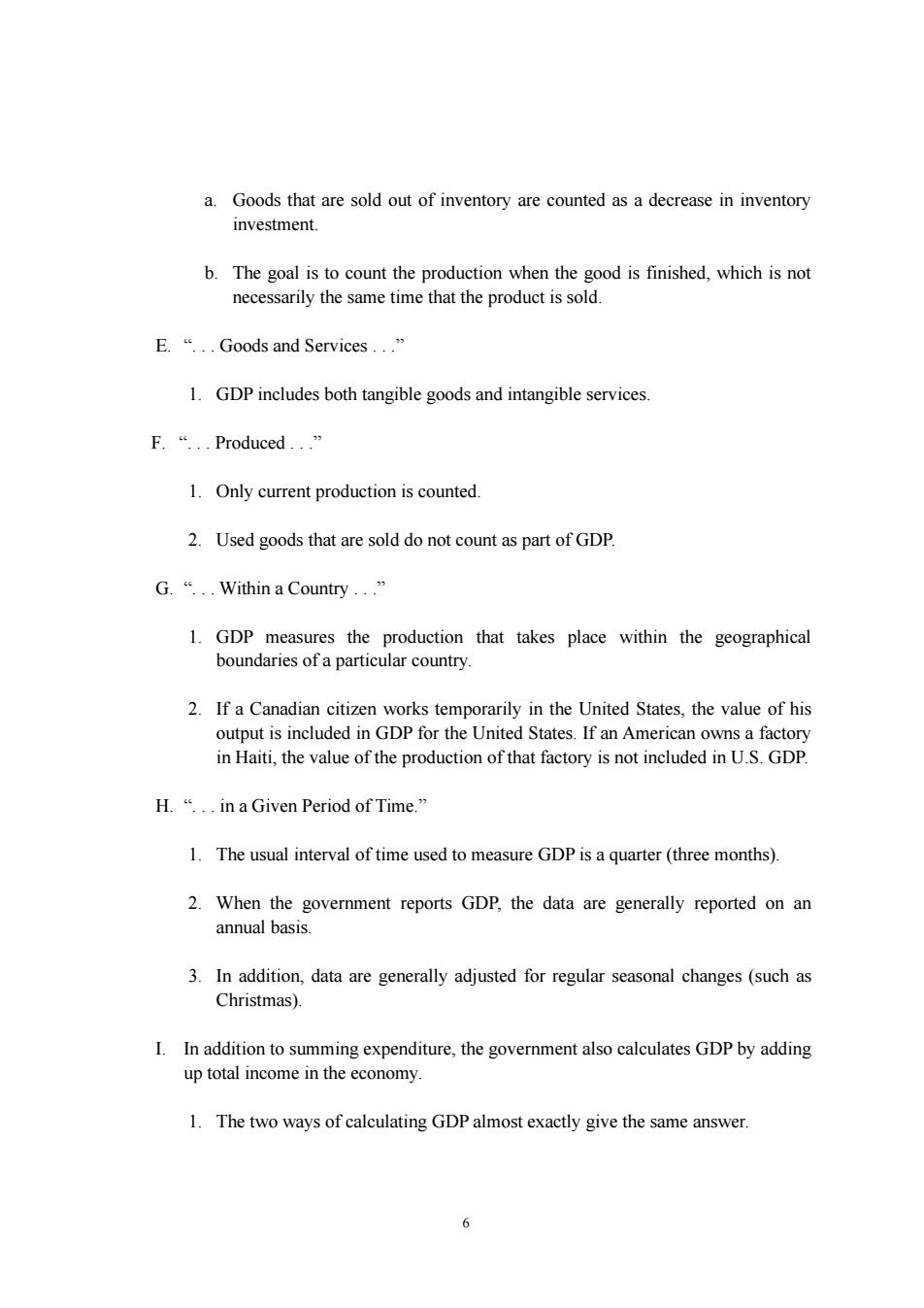
a.Goods that are sold out of inventory are counted as a decrease in inventory investment. b.The goal is to count the production when the good is finished,which is not necessarily the same time that the product is sold. E."..Goods and Services.." 1.GDP includes both tangible goods and intangible services F.“..Produced." 1.Only current production is counted 2.Used goods that are sold do not count as part of GDP G."...Within a Country..." GDDures the production that takes place within the geographical aries of a particular country 2.If a Canadian citizen works temporarily in the United States,the value of his output is included in GDP for the United States.If an American owns a factory in Haiti,the value of the production of that factory is not included in U.S.GDP H.“.in a Given Period of Time. 1.The usual interval of time used to measure GDP is a quarter(three months). 2.When the government reports GDP the data are generally reported on an annual basis 3.In addition,data are generally adjusted for regular seasonal changes (such as Christmas). I.In addition to summing expenditure,the government also calculates GDP by adding up total income in the economy. 1.The two ways of calculating GDP almost exactly give the same answer. 6
6 a. Goods that are sold out of inventory are counted as a decrease in inventory investment. b. The goal is to count the production when the good is finished, which is not necessarily the same time that the product is sold. E. “. . . Goods and Services . . .” 1. GDP includes both tangible goods and intangible services. F. “. . . Produced . . .” 1. Only current production is counted. 2. Used goods that are sold do not count as part of GDP. G. “. . . Within a Country . . .” 1. GDP measures the production that takes place within the geographical boundaries of a particular country. 2. If a Canadian citizen works temporarily in the United States, the value of his output is included in GDP for the United States. If an American owns a factory in Haiti, the value of the production of that factory is not included in U.S. GDP. H. “. . . in a Given Period of Time.” 1. The usual interval of time used to measure GDP is a quarter (three months). 2. When the government reports GDP, the data are generally reported on an annual basis. 3. In addition, data are generally adjusted for regular seasonal changes (such as Christmas). I. In addition to summing expenditure, the government also calculates GDP by adding up total income in the economy. 1. The two ways of calculating GDP almost exactly give the same answer
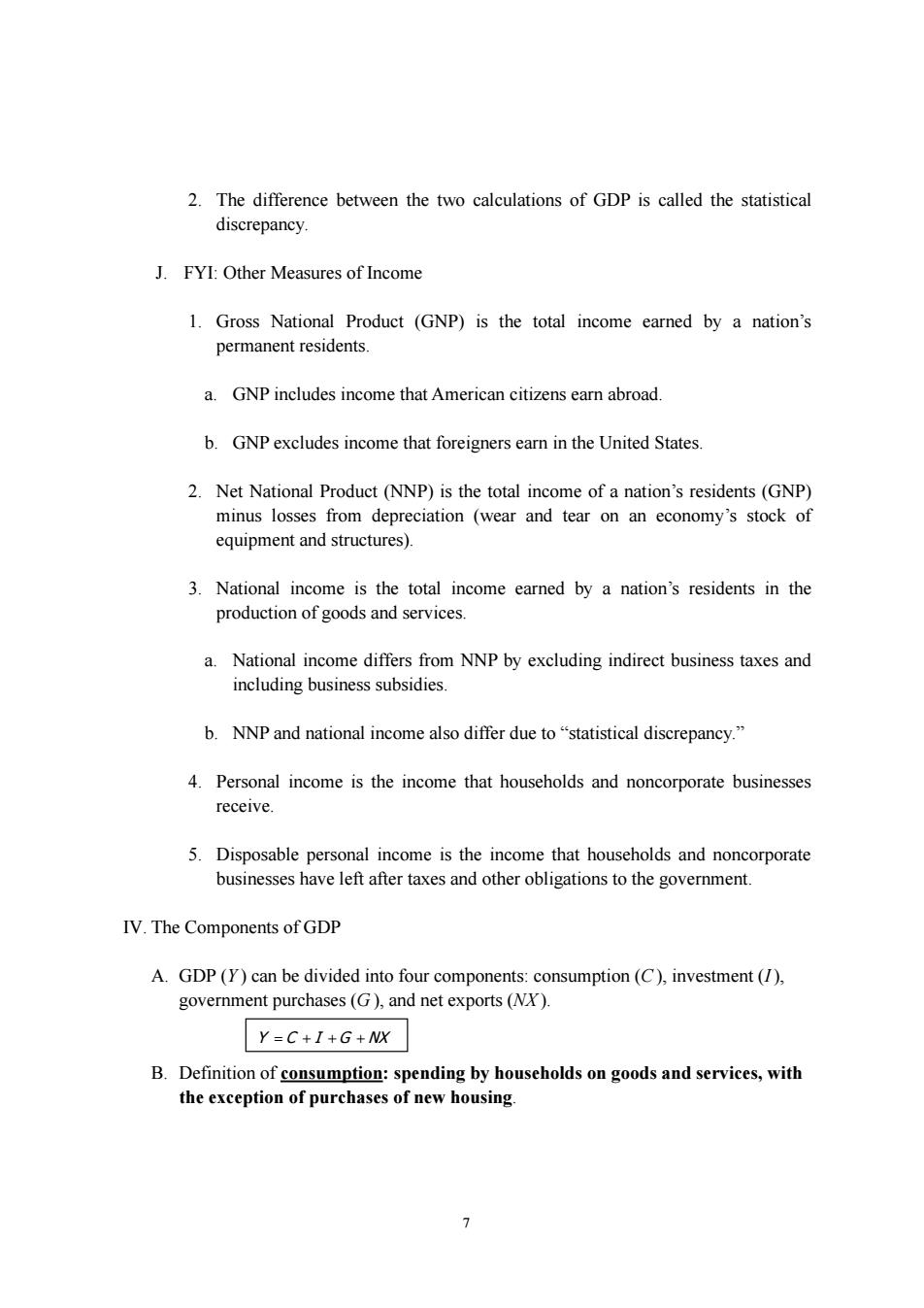
2.The difference between the two calculations of GDP is called the statistical discrepancy. J.FYI:Other Measures of Income 1.Gross National Product (GNP)is the total income earned by a nation's permanent residents. a.GNP includes income that American citizens earn abroad b.GNP excludes income that foreigners earn in the United States. 2.Net National Product (NNP)is the total income of a nation's residents (GNP) minus losses from depreciation (wear and tear on an economy's stock of equipment and structures). 3.National income is the total income earned by a nation's residents in the production of goods and services. a.National income differs from NNP by excluding indirect business taxes and including business subsidies b.NNP and national income also differ due to"statistical discrepancy." 4.Personal income is the income that households and noncorporate businesses receive. 5.Disposable personal income is the income that households and noncorporate businesses have left after taxes and other obligations to the government. IV.The Components of GDP A.GDP(Y)can be divided into four components:consumption(C),investment(), government purchases (G).and net exports (N). Y=C+I+G+NX B.Definition of consumption:spending by households on goods and services,with the exception of purchases of new housing. 7
7 2. The difference between the two calculations of GDP is called the statistical discrepancy. J. FYI: Other Measures of Income 1. Gross National Product (GNP) is the total income earned by a nation’s permanent residents. a. GNP includes income that American citizens earn abroad. b. GNP excludes income that foreigners earn in the United States. 2. Net National Product (NNP) is the total income of a nation’s residents (GNP) minus losses from depreciation (wear and tear on an economy’s stock of equipment and structures). 3. National income is the total income earned by a nation’s residents in the production of goods and services. a. National income differs from NNP by excluding indirect business taxes and including business subsidies. b. NNP and national income also differ due to “statistical discrepancy.” 4. Personal income is the income that households and noncorporate businesses receive. 5. Disposable personal income is the income that households and noncorporate businesses have left after taxes and other obligations to the government. IV. The Components of GDP A. GDP (Y ) can be divided into four components: consumption (C), investment (I), government purchases (G ), and net exports (NX ). B. Definition of consumption: spending by households on goods and services, with the exception of purchases of new housing. Y C I G NX
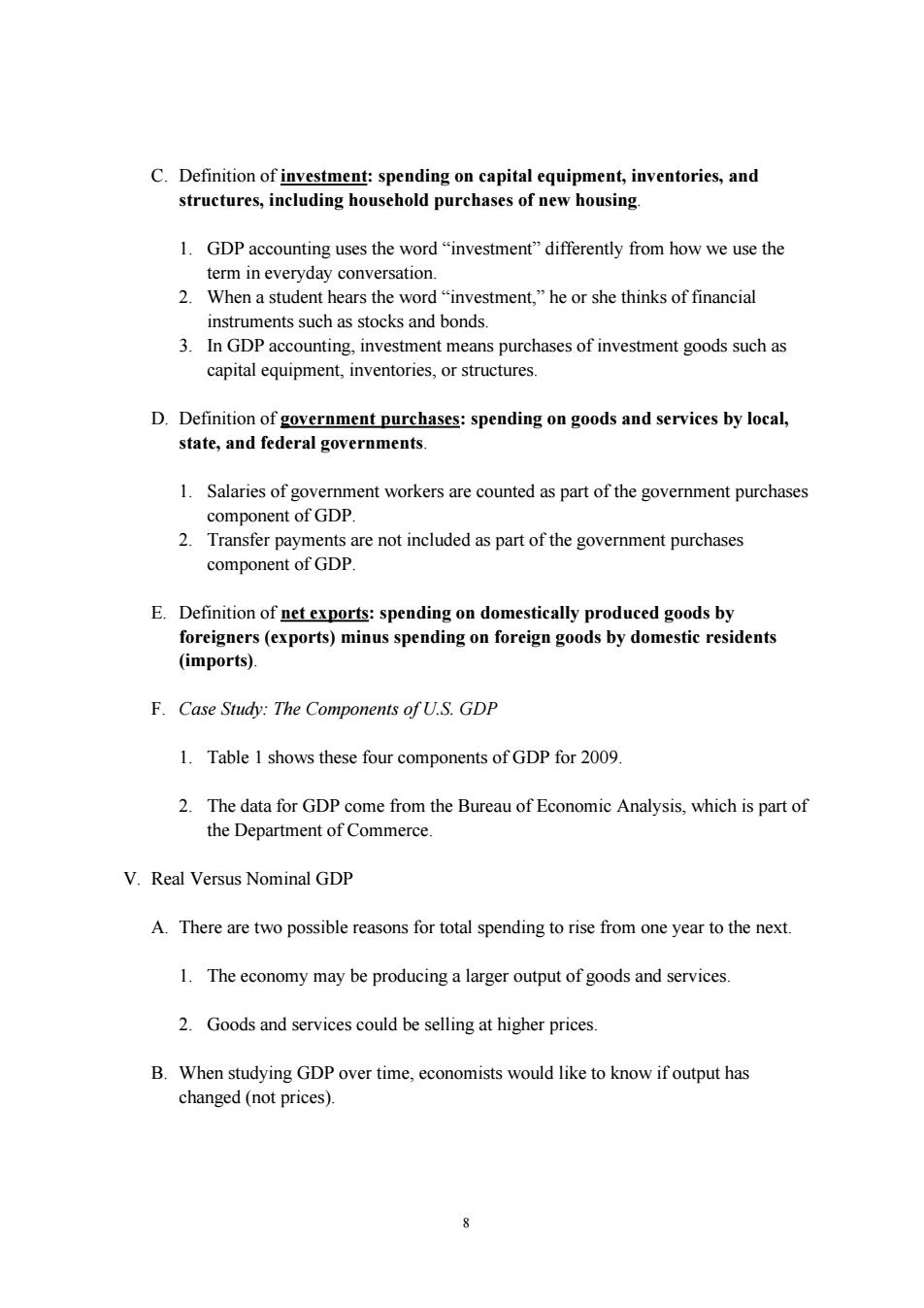
C.Definition of investment:spending on capital equipment,inventories,and structures,including household purchases of new housing. 1.GDP accounting uses the word"investment"differently from how we use the term in everyday conversation 2.When a student hears the word"investment,"he or she thinks of financial instruments such as stocks and bonds. 3.In GDP accounting,investment means purchases of investment goods such as capital equipment,inventories,or structures D.Definition of government purchases:spending on goods and services by local, state,and federal governments. 1.Salaries of government workers are counted as part of the government purchases component of GDP. 2.Transfer payments are not included as part of the government purchases component of GDP E.Definition of net exports:spending on domestically produced goods by foreigne rs(exports)minus spending on foreign goods by domestic residents (imports) F.Case Study:The Components ofU.S.GDP 1.Table 1 shows these four components of GDP for 2009 2.The data for GDP come from the Bureau of Economic Analysis,which is part of the Department of Commerce. V.Real Versus Nominal GDP A.There are two possible reasons for total spending to rise from one year to the next 1.The economy may be producing a larger output of goods and services. 2.Goods and services could be selling at higher prices. B.When studying GDP over time,economists would like to know ifoutput has changed (not prices)
8 C. Definition of investment: spending on capital equipment, inventories, and structures, including household purchases of new housing. 1. GDP accounting uses the word “investment” differently from how we use the term in everyday conversation. 2. When a student hears the word “investment,” he or she thinks of financial instruments such as stocks and bonds. 3. In GDP accounting, investment means purchases of investment goods such as capital equipment, inventories, or structures. D. Definition of government purchases: spending on goods and services by local, state, and federal governments. 1. Salaries of government workers are counted as part of the government purchases component of GDP. 2. Transfer payments are not included as part of the government purchases component of GDP. E. Definition of net exports: spending on domestically produced goods by foreigners (exports) minus spending on foreign goods by domestic residents (imports). F. Case Study: The Components of U.S. GDP 1. Table 1 shows these four components of GDP for 2009. 2. The data for GDP come from the Bureau of Economic Analysis, which is part of the Department of Commerce. V. Real Versus Nominal GDP A. There are two possible reasons for total spending to rise from one year to the next. 1. The economy may be producing a larger output of goods and services. 2. Goods and services could be selling at higher prices. B. When studying GDP over time, economists would like to know if output has changed (not prices)
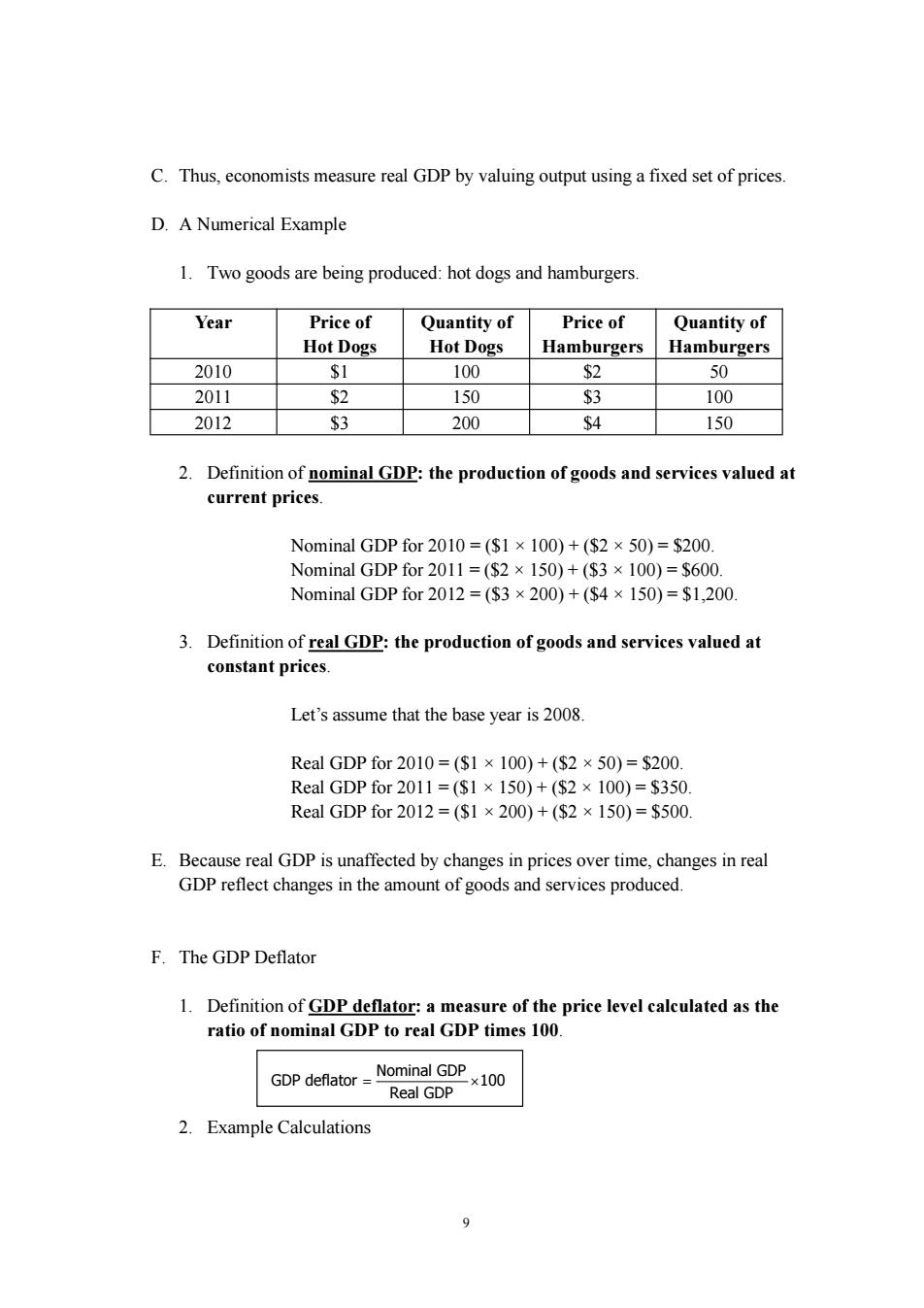
C.Thus,economists measure real GDP by valuing output using a fixed set of prices. D.A Numerical Example 1. Two goods are being produced:hot dogs and hamburgers Year Price of Quantity of Price of Quantity of Hot Dogs Hot Dogs Hamburgers Hamburgers 2010 1 100 50 2011 50 83 2012 $3 200 $4 150 2. Definition of nominal GDP:the production of goods and services valued at current prices. Nominal GDP for2010=(S1×100)+($2×50)=S200. Nominal gDP for2011=($2×150)+($3×100)=$600 Nominal GDP for2012=(53×200)+($4×150)=$1,200 3.Definition of real GDP:the production of goods and services valued at constant prices. Let's assume that the base year is 2008. Real GDP for2010=($1×100)+($2×50)=$200 Real GDP for2011=(S1×150)+(S2×100)=$350 Real GDP for2012=($1×200)+($2×150)=$500 E.Becaus real DP isunaffected by changes in prices over time anges in real GDP reflect changes in the amount of goods and services produced F.The GDP Deflator 1.Definition of GDP deflator:a measure of the price level calculated as the ratio of nominal GDP to real GDP times 100 2. Example Calculation
9 C. Thus, economists measure real GDP by valuing output using a fixed set of prices. D. A Numerical Example 1. Two goods are being produced: hot dogs and hamburgers. Year Price of Hot Dogs Quantity of Hot Dogs Price of Hamburgers Quantity of Hamburgers 2010 $1 100 $2 50 2011 $2 150 $3 100 2012 $3 200 $4 150 2. Definition of nominal GDP: the production of goods and services valued at current prices. Nominal GDP for 2010 = ($1 × 100) + ($2 × 50) = $200. Nominal GDP for 2011 = ($2 × 150) + ($3 × 100) = $600. Nominal GDP for 2012 = ($3 × 200) + ($4 × 150) = $1,200. 3. Definition of real GDP: the production of goods and services valued at constant prices. Let’s assume that the base year is 2008. Real GDP for 2010 = ($1 × 100) + ($2 × 50) = $200. Real GDP for 2011 = ($1 × 150) + ($2 × 100) = $350. Real GDP for 2012 = ($1 × 200) + ($2 × 150) = $500. E. Because real GDP is unaffected by changes in prices over time, changes in real GDP reflect changes in the amount of goods and services produced. F. The GDP Deflator 1. Definition of GDP deflator: a measure of the price level calculated as the ratio of nominal GDP to real GDP times 100. 2. Example Calculations Nominal GDP GDP deflator 100 Real GDP
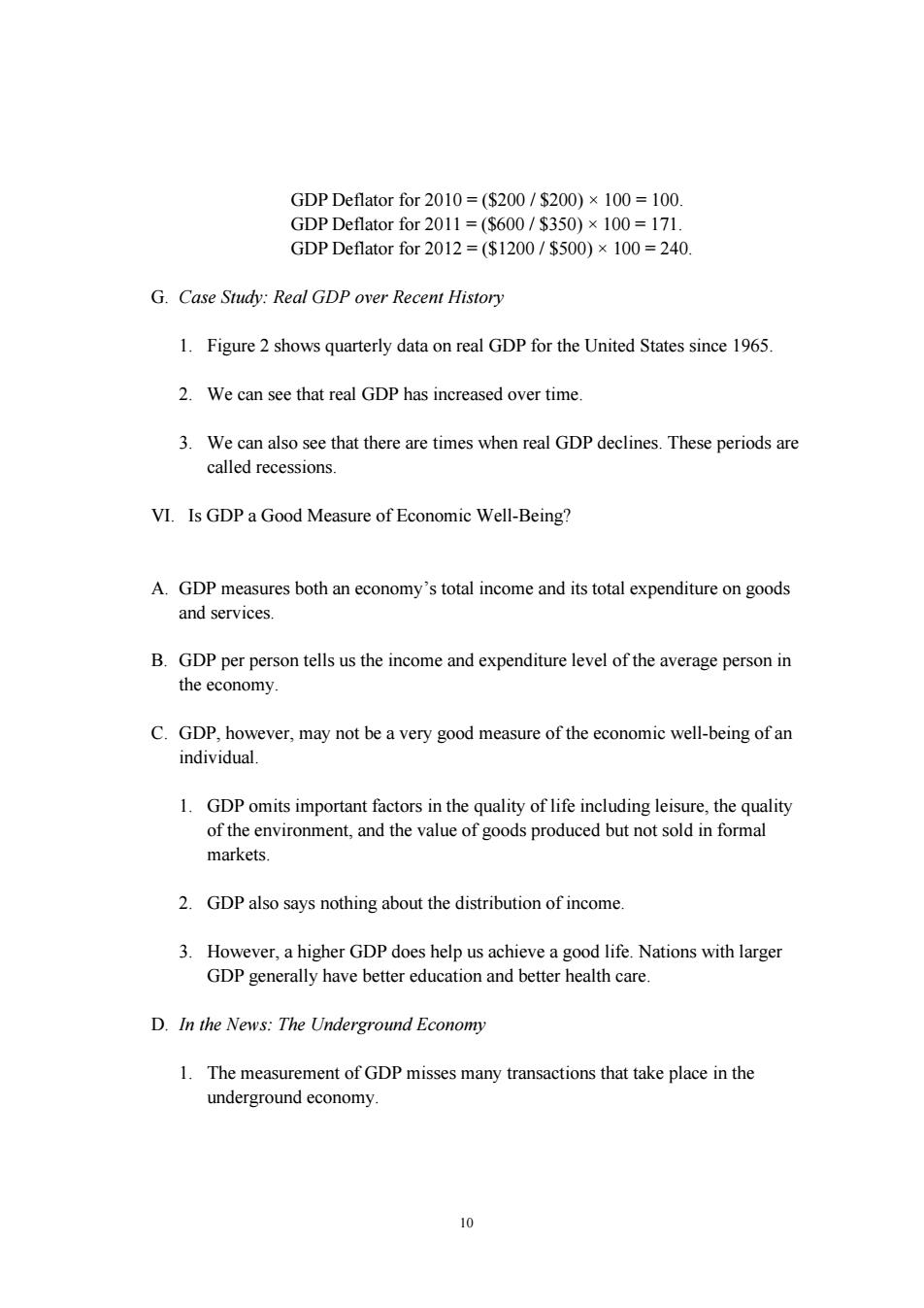
GDP Deflator for 2010=($200/$200)x 100=100 GDP Deflator for2011=($600/$350)×100=171. GDP Deflator for2012=($1200/$500)×100=240 G.Case Study:Real GDP over Recent History 1.Figure 2 shows quarterly data on real GDP for the United States since 1965. 2.We can see that real GDP has increased over time 3.We can also see that there are times when real GDP declines.These periods are called recessions. VI.Is GDP a Good Measure of Economic Well-Being? A.GDP measures both an economy's total income and its total expenditure on goods and services. B.GDP per person tells us the income and expenditure level of the average person in the economy C.GDP,however,may not be a very good measure of the economic well-being of an individual 1.GDP omits important factors in the quality of life including leisure,the quality of the environment,and the value of goods produced but not sold in formal markets. 2.GDP also says nothing about the distribution of income 3.However,a higher GDP does help us achieve a good life.Nations with larger GDP generally have better education and better health care. D.In the News:The Underground Econom 1.The measurement of GDP misses many transactions that take place in the underground economy 10
10 GDP Deflator for 2010 = ($200 / $200) × 100 = 100. GDP Deflator for 2011 = ($600 / $350) × 100 = 171. GDP Deflator for 2012 = ($1200 / $500) × 100 = 240. G. Case Study: Real GDP over Recent History 1. Figure 2 shows quarterly data on real GDP for the United States since 1965. 2. We can see that real GDP has increased over time. 3. We can also see that there are times when real GDP declines. These periods are called recessions. VI. Is GDP a Good Measure of Economic Well-Being? A. GDP measures both an economy’s total income and its total expenditure on goods and services. B. GDP per person tells us the income and expenditure level of the average person in the economy. C. GDP, however, may not be a very good measure of the economic well-being of an individual. 1. GDP omits important factors in the quality of life including leisure, the quality of the environment, and the value of goods produced but not sold in formal markets. 2. GDP also says nothing about the distribution of income. 3. However, a higher GDP does help us achieve a good life. Nations with larger GDP generally have better education and better health care. D. In the News: The Underground Economy 1. The measurement of GDP misses many transactions that take place in the underground economy